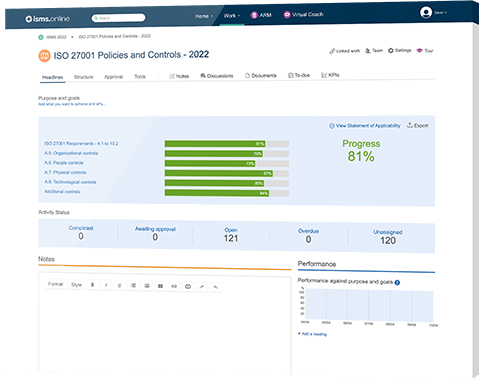
Control 5.21 governs how organisations manage information security risks throughout their ICT supply chain, by implementing robust processes and procedures prior to the supply of any products or services.
5.21 is a preventative control that maintains risk by establishing an “agreed level of security” between both parties throughout the ICT supply chain.
| Control Type | Information Security Properties | Cybersecurity Concepts | Operational Capabilities | Security Domains |
|---|---|---|---|---|
| #Preventative | #Confidentiality #Integrity #Availability | #Identify | #Supplier Relationships Security | #Governance and Ecosystem #Protection |
Control 5.21 is explicitly focused on the provision of ICT services, via a supplier or group of suppliers.
As such, ownership should rest with the person responsible for acquiring, managing and renewing ICT supplier relationships across all business functions, such as a Chief Technical Officer or Head of IT.
With ISMS.online, challenges around version control, policy approval & policy sharing are a thing of the past.
ISO stipulates 13 ICT-related guidance points that should be considered alongside any other controls that dictate an organisation’s relationship with its supplier(s).
Given the expansion of cross-platform on-premise and cloud services over the last decade, Control 5.21 deals with the supply of both hardware and software-related components and services (both on-premise and cloud-based), and rarely draws a distinction between the two.
As well as the relationship between the supplier and the organisation, several controls also deal with a supplier’s obligations when sub-contracting elements of the supply chain to third-party organisations.
It’s important to note that ICT supply chain governance should not be taken in isolation, in accordance with this control. Control 5.21 is designed to complement existing supply chain management procedures, and offer context for ICT-specific products and services.
ISO acknowledges that, especially when it comes to software components, quality control within the sphere of ICT products and services does not extend to granular inspection of the supplier’s own set of compliance procedures.
As such, organisations are encouraged to identify supplier-specific checks that verify the supplier as a “reputable source” and draft agreements that categorically state the supplier’s information security obligations, when fulfilling a contract, order or providing a service.
ISO 27002:2022-5.21 replaces ISO 27002:2013-15.1.3 (Information and communication technology supply chain).
ISO 27002:2022-5.21 adheres to the same set of general guidance rules as ISO 27002:2013-15.1.3, but places a far greater emphasis on a supplier’s obligation to provide and verify component-related information at point of supply, including:
ISO 27002:2022-5.21 also asks the organisation to create additional component-specific information to increase general levels of information security when introducing products and services, including:
At ISMS.online, we’ve built a comprehensive and easy to use system that can help you to implement ISO 27002 controls and manage your entire ISMS.
Our cloud-based platform offers:
ISMS.online has all of these features, and more.
Get in touch today to book a demo.

We’ll give you an 81% headstart
from the moment you log in
Book your demo
| ISO/IEC 27002:2022 Control Identifier | ISO/IEC 27002:2013 Control Identifier | Control Name |
|---|---|---|
| 5.7 | New | Threat intelligence |
| 5.23 | New | Information security for use of cloud services |
| 5.30 | New | ICT readiness for business continuity |
| 7.4 | New | Physical security monitoring |
| 8.9 | New | Configuration management |
| 8.10 | New | Information deletion |
| 8.11 | New | Data masking |
| 8.12 | New | Data leakage prevention |
| 8.16 | New | Monitoring activities |
| 8.23 | New | Web filtering |
| 8.28 | New | Secure coding |
| ISO/IEC 27002:2022 Control Identifier | ISO/IEC 27002:2013 Control Identifier | Control Name |
|---|---|---|
| 6.1 | 07.1.1 | Screening |
| 6.2 | 07.1.2 | Terms and conditions of employment |
| 6.3 | 07.2.2 | Information security awareness, education and training |
| 6.4 | 07.2.3 | Disciplinary process |
| 6.5 | 07.3.1 | Responsibilities after termination or change of employment |
| 6.6 | 13.2.4 | Confidentiality or non-disclosure agreements |
| 6.7 | 06.2.2 | Remote working |
| 6.8 | 16.1.2, 16.1.3 | Information security event reporting |
| ISO/IEC 27002:2022 Control Identifier | ISO/IEC 27002:2013 Control Identifier | Control Name |
|---|---|---|
| 7.1 | 11.1.1 | Physical security perimeters |
| 7.2 | 11.1.2, 11.1.6 | Physical entry |
| 7.3 | 11.1.3 | Securing offices, rooms and facilities |
| 7.4 | New | Physical security monitoring |
| 7.5 | 11.1.4 | Protecting against physical and environmental threats |
| 7.6 | 11.1.5 | Working in secure areas |
| 7.7 | 11.2.9 | Clear desk and clear screen |
| 7.8 | 11.2.1 | Equipment siting and protection |
| 7.9 | 11.2.6 | Security of assets off-premises |
| 7.10 | 08.3.1, 08.3.2, 08.3.3, 11.2.5 | Storage media |
| 7.11 | 11.2.2 | Supporting utilities |
| 7.12 | 11.2.3 | Cabling security |
| 7.13 | 11.2.4 | Equipment maintenance |
| 7.14 | 11.2.7 | Secure disposal or re-use of equipment |